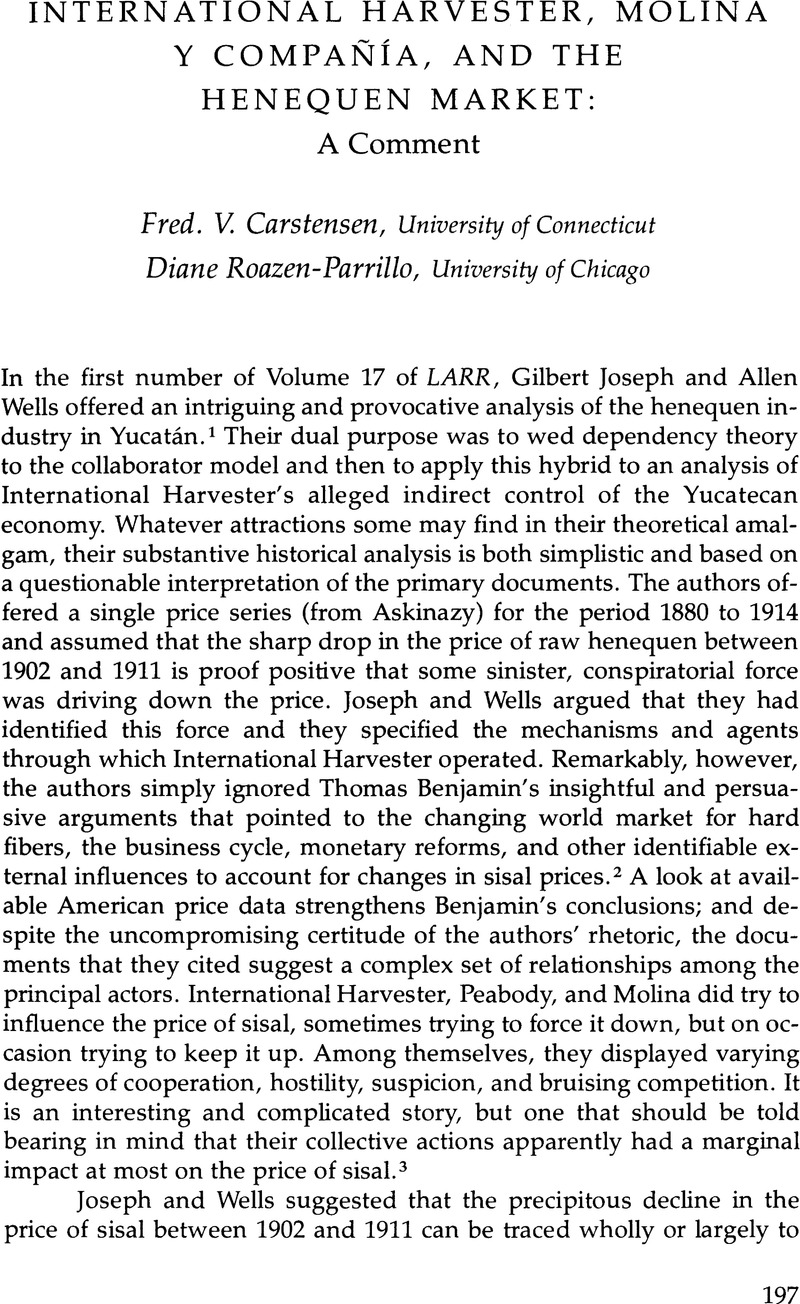Published online by Cambridge University Press: 24 October 2022

1. Gilbert M. Joseph and Allen Wells, “Corporate Control of a Monocrop Economy,” Latin American Research Review 17, 1:69-99.
2. Thomas Benjamin, “International Harvester and the Henequen Marketing System in Yucatán, 1898-1915: A New Perspective,” Inter-American Economic Affairs 21, 3:3-19.
3. We have begun writing an article on the development of the American twine market and the parallel rise of the Yucatecan henequen industry.
4. For a general discussion of the twine market in the United States, see Diane Roazen-Parrillo, “U.S. Business Interests and the Sisal Industry of Yucatán, Mexico, 1876-1924,” Ph.D. Diss., University of Chicago, to be completed circa August, 1982. On the possible 1909 corner, see E. Bayley to A. Pierce, 22 September 1909, H. W. Peabody papers, Baker Library (hereafter HWP), HL-3.
5. Using a five-year moving average, the best periods were 1903-7, 6.77⊄; 1888-92, 6.72⊄; 1887-91, 6.66⊄; 1902-6, 6.61⊄; and 1904-8, 6.61⊄. Based on table.
6. We have seen no documents in the McCormick records showing that that firm knew for whom or in what volume Peabody was buying sisal. In 1931 Bayley stated that McCormick never asked for details and was given none during the period of the financial partnership (ca. 1890-1903). E. Bayley to G. McPherson, 23 April 1931, HWP, HL-3.
7. McCormick decided to build its own twine mill in Chicago in early 1899, but still had to contract for some outside production. La Industrial apparently did have a small contract during 1900 and 1901, although detailed information has not yet come to light. See Memo of Agreement, 20-21 September 1900, HWP, HL-3.
8. C. H. McCormick to G. W. Perkins, 26 September 1902. McCormick Papers, State Historical Society of Wisconsin, series 2C:30, File: IHC, Consolidation: 1901-1908. E. Bayley to A. Pierce, 14 October 1902, HWP, HL-3. Bayley's letter provides a specific breakdown of the weekly orders that each of the four brokerage houses were to handle.
9. C. Detzer to Executive Committee, 7 November 1902 (Report of Meeting of Twine and Fiber Committee, No. 1). International Harvester Archives (hereafter IHA), file 2395.
10. E. Bayley to A. Pierce, 18 February 1903, HWP, HL-3.
11. The letter of 29 October 1903 is reproduced in Bureau of Corporations, The International Harvester Company (Washington, 1913), pp. 149-50. The bureau believed some investigation was carried out, but no further action was taken.
12. H. L. Daniels to A. Legge, 16 July 1909, IHA, 2395.
13. Trading Profit Ledgers, IHA, 3014-15. The Bureau of Corporations investigation of International Harvester (see note 11 above) also observed the comparatively low profits on twine compared to other lines.
14. Analysis of sources of fiber from H. L. Boyle Economic Research Files, IHA, no file. Reproduced in Roazen-Parrillo. E. Bayley to A. Pierce, 22 September 1909, HWP, HL-3.